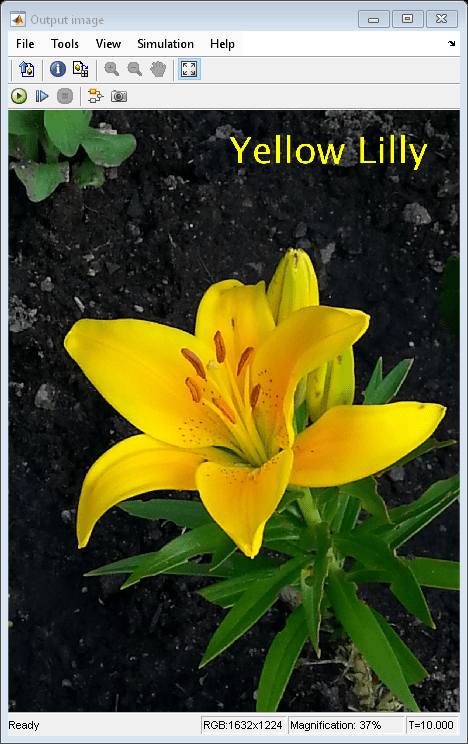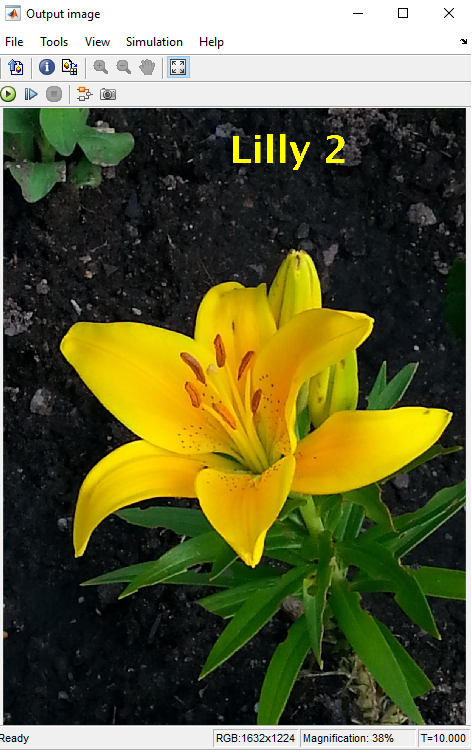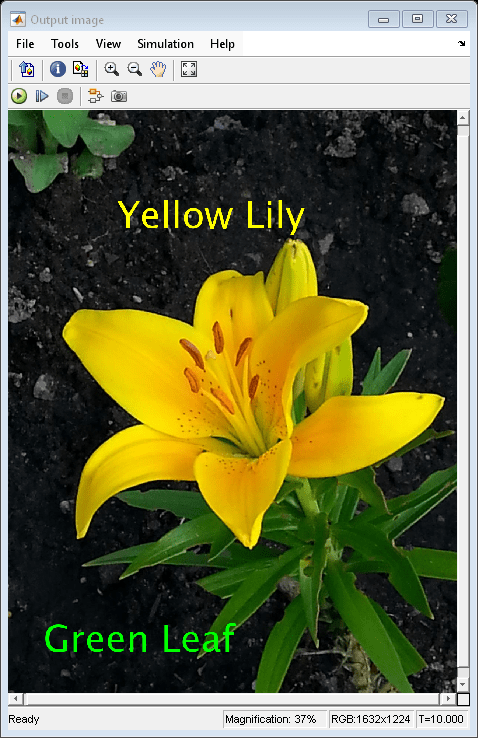Insert Text
Draw text on images or video frames
Libraries:
Computer Vision Toolbox /
Text & Graphics
Description
The Insert Text block draws formatted text on an input image or video stream. The block produces stylized text bitmaps using the open-source font engine Free Type 2.3.5 library. For more information about the library, see The FreeType Project website.
Note
This block supports only ASCII characters.
This block enables you to insert:
A single instance of text
Multiple instances of the same text
Multiple instances of text, with different text at each location
Examples
Select String to Insert into Image
Select a text string and insert it into an image when the Insert Text block contains multiple text strings.
Insert Two Strings into Image at Different Locations
Insert two strings of different colors into an image at different location within the image.
Ports
Input
Input image or video, specified as an M-by-N matrix, M-by-N-by-T array, M-by-N-by-C array, or M-by-N-by-C-by-T array. T is the number of frames in a video or image sequence, and C is the number of color channels.
Dependencies
To enable this port, set the Image signal parameter to
One multidimensional signal.
Data Types: single | double | int8 | int16 | int32 | uint8 | uint16 | uint32 | Boolean
Red color component of the input image or video, specified as an M-by-N matrix or M-by-N-by-T array, where T is the number of frames in the input video.
Note
Inputs to the R, G, and B ports must have the same dimensions and data type.
Dependencies
To enable this port, set the Image signal parameter to
Separate color signals.
Data Types: single | double | int8 | int16 | int32 | uint8 | uint16 | uint32 | Boolean
Green color component of the input image or video, specified as an M-by-N matrix or M-by-N-by-T array, where T is the number of frames in the input video.
Note
Inputs to the R, G, and B ports must have the same dimensions and data type.
Dependencies
To enable this port, set the Image signal parameter to
Separate color signals.
Data Types: single | double | int8 | int16 | int32 | uint8 | uint16 | uint32 | Boolean
Blue color component of the input image or video, specified as an M-by-N matrix or M-by-N-by-T array, where T is the number of frames in the input video.
Note
Inputs to the R, G, and B ports must have the same dimensions and data type.
Dependencies
To enable this port, set the Image signal parameter to
Separate color signals.
Data Types: single | double | int8 | int16 | int32 | uint8 | uint16 | uint32 | Boolean
Select the display text, specified as a positive integer.
Select a display text from the cell array using this port, when the input to the
Text parameter is a cell array of character vectors. For
example, the value to the Select port must be in the range
[1, S], when the Text
parameter is a cell array of S character vectors.
Dependencies
To enable this port, specify the Text parameter as a cell array of character vectors.
Data Types: int8 | int16 | int32 | uint8 | uint16 | uint32 | Boolean
Text color value, specified as a scalar, a vector or a matrix. Use this table to determine the type of input value to this port.
| Input Image | Same Color for All Text | Different Color for Each Character Vector |
|---|---|---|
| Intensity image | scalar value | S-element vector. S is the number of character vectors in the cell array specified to Text parameter. |
| Color image | three-element vector | S-by-3 matrix. S is the number of character vectors in the cell array specified to Text parameter. |
The data type of the input image determines the range of color values. For
example, a color value for a floating-point input image data type is in the range
[0, 1]. For an input image with a
uint8 data type, the value is in the range [0,
255].
Note
The input to this port must be of the same data type as the input image.
Dependencies
To enable this port, set the Color value source parameter
to Input port.
Data Types: single | double | int8 | int16 | int32 | uint8 | uint16 | uint32
Location index, specified as a two-element vector of the form [x
y] or an S-by-2 matrix. [x y]
specify the coordinates of the input image to display the text. Specify it as an
S-by-2 matrix, to display S character vectors
at different locations in the image.
Dependencies
To enable this port, set the Location source parameter to
Input port.
Data Types: int8 | int16 | int32 | uint8 | uint16 | uint32
Opacity factor, specified as a scalar or an S-element vector.
Scalar — Specify same opacity value to all the display text.
S-element vector — Specify different opacity values to S character vectors specified in the Text parameter.
Specify opacity values in the range [0,
1].
Note
The input to the Image, R, G, B, and Color ports must be of the same data type as the input to this port.
Dependencies
To enable this port, set the Opacity source parameter to
Input port.
Data Types: single | double
Text variable values, specified as a scalar or a vector. The block replaces the
format specifiers such as %d, %f, or
%s in the Text parameter, with the
elements specified by the Variables port.
Use the Variables port to display S character vectors or numerical values simultaneously, at S locations of the input image or video frame. The input to this port depends on the type of format specifier specified to the Text parameter.
| Display Text | Data Type | Format Specifier | Input to the Variables Port |
|---|---|---|---|
| Character vectors | uint8 | '%s', '%c' |
['Text1' 0 'Text2' 0 .... 0
'TextS'] |
| Integers | uint8, uint16,
uint32, int8,
int16, int32 | '%d', '%i', '%o', '%x', '%X' | [x1 x2
x3....
xS] |
| Floating point numbers | single, double | '%f', '%e', '%E', '%g', '%G' | [x1 x2
x3....
xS] |
For more information on format specifiers, see sprintf.
Dependencies
To enable this port, enter ANSI C printf-style format
specifiers, such as '%d', '%f', or
'%s' in the Text parameter.
Data Types: single | double | int8 | int16 | int32 | uint8 | uint16 | uint32
Output
Output image or video, returned as an M-by-N matrix, M-by-N-by-T array, M-by-N-by-C array, or M-by-N-by-C-by-T array. T is the number of frames in a video or image sequence, and C is the number of color channels.
Dependencies
To enable this port, set the Image signal parameter to
One multidimensional signal.
Data Types: single | double | int8 | int16 | int32 | uint8 | uint16 | uint32 | Boolean
Red color component of the output image or video, returned as an M-by-N matrix or M-by-N-by-T array, where T is the number of frames in the output video.
Dependencies
To enable this port, set the Image signal parameter to
Separate color signals.
Data Types: single | double | int8 | int16 | int32 | uint8 | uint16 | uint32 | Boolean
Green color component of the output image or video, returned as an M-by-N matrix or M-by-N-by-T array, where T is the number of frames in the output video.
Dependencies
To enable this port, set the Image signal parameter to
Separate color signals.
Data Types: single | double | int8 | int16 | int32 | uint8 | uint16 | uint32 | Boolean
Blue color component of the output image or video, returned as an M-by-N matrix or M-by-N-by-T array, where T is the number of frames in the output video.
Dependencies
To enable this port, set the Image signal parameter to
Separate color signals.
Data Types: single | double | int8 | int16 | int32 | uint8 | uint16 | uint32 | Boolean
Parameters
Main
Specify the text to insert into the image, as a character vector or a cell array of character vectors. You can display either a single text or multiple texts simultaneously, using the Text parameter.
Single text — You can specify Text parameter as either a character vector or a cell array of S character vectors. If you specify a cell array, select one-out-of-S character vectors from the cell array, by using the Select input port.
Multiple texts simultaneously — You can specify ANSI C
printf-style format specifiers in the Text parameter. You can then specify the texts by using the Variable input port. Supported format specifiers include%d,%i,%u,%o,%x,%X,%c,%s,%f,%e,%E,%g, and%G. For more information on format specifiers, seesprintf.
Use this table to determine the type of input value to the Text parameter.
| Display | Input toText parameter | Status of Select port | Status of Variables port |
|---|---|---|---|
| A character vector | Single character vector such as 'Text' | Disabled | Disabled |
| One-out-of-S character vectors | Cell array of S character vectors such as
{'Text1', 'Text2',....,
'TextS'} | Enabled | Disabled |
| S character vectors | Format specifier such as '%s' | Disabled | Enabled |
Select the text color source as either Specify via
dialog or Input port. You can specify this
parameter as Specify via dialog to specify insert text
colors using the Color value parameter. You can specify this
parameter as Input port to specify text colors by using the
Color input port.
Text color value specified as a scalar, a vector, or a matrix. Use this table to determine the type of input value to this port.
| Input Image | Same Color for All Text | Different Color for Each Character Vector |
|---|---|---|
| Intensity image | scalar value | S-element vector. S is the number of character vectors in the cell array specified to the Text parameter. |
| Color image | three-element vector | S-by-3 matrix. S is the number of character vectors in the cell array specified to the Text parameter. |
The data type of the input image determines the range of color values. For
example, a color value for a floating-point input image data type is in the range
[0, 1]. For an input image with a
uint8 data type, the value is in the range [0,
255].
Dependencies
To enable this parameter, set the Color value source
parameter to Specify via dialog.
Specify the source of location coordinates of the display text as one these options:
Specify via dialog— Use the Location [x y] parameter to specify location coordinates of the display text.Input port— Use the Location input port to specify location coordinates of the display text.
Text location index, specified as a two-element vector [x y] or
an S-by-2 matrix. [x y] specify the coordinates
of the input image to display the text. Specify the value as an
S-by-2 matrix, to display S character vectors at
different locations in the image.
Dependencies
To enable this parameter, set the Location source parameter
to Specify via dialog.
Specify opacity factor source as one of these options:
Specify via dialog— Use the Opacity parameter to specify opacity factor.Input port— Use the Opacity input port to specify opacity factor.
Opacity factor, specified as a scalar or an S-element vector.
Scalar — Specify same opacity value to the display text.
S-element vector — Specify different opacity values to S character vectors specified to the Text parameter
Specify opacity value in the range [0,
1].
Dependencies
To enable this parameter, set the Opacity source parameter
to Specify via dialog.
Specify the format of the input and output images of the block using these options:
One multidimensional signal— The block enables a single input port and single output port.Separate color signals— The block enables R, G, and B input and output signal ports for the respective color channels of the image.
Enable this parameter to mirror the text string and reverse its location in the
image from [x y] to [y x].
Font
Specify the font of the inserted text. The block populates this list with the fonts installed on your system. On Windows®, the block searches the system registry for font files. On UNIX, the block searches the font path of the X Server for font files.
Specify the font size of the inserted text.
Enable this parameter to smooth the edges of the inserted text. The smoothing process is computationally expensive.
Block Characteristics
Extended Capabilities
C/C++ Code Generation
Generate C and C++ code using Simulink® Coder™.
Version History
Introduced in R2013a
See Also
MATLAB Command
You clicked a link that corresponds to this MATLAB command:
Run the command by entering it in the MATLAB Command Window. Web browsers do not support MATLAB commands.
웹사이트 선택
번역된 콘텐츠를 보고 지역별 이벤트와 혜택을 살펴보려면 웹사이트를 선택하십시오. 현재 계신 지역에 따라 다음 웹사이트를 권장합니다:
또한 다음 목록에서 웹사이트를 선택하실 수도 있습니다.
사이트 성능 최적화 방법
최고의 사이트 성능을 위해 중국 사이트(중국어 또는 영어)를 선택하십시오. 현재 계신 지역에서는 다른 국가의 MathWorks 사이트 방문이 최적화되지 않았습니다.
미주
- América Latina (Español)
- Canada (English)
- United States (English)
유럽
- Belgium (English)
- Denmark (English)
- Deutschland (Deutsch)
- España (Español)
- Finland (English)
- France (Français)
- Ireland (English)
- Italia (Italiano)
- Luxembourg (English)
- Netherlands (English)
- Norway (English)
- Österreich (Deutsch)
- Portugal (English)
- Sweden (English)
- Switzerland
- United Kingdom (English)



